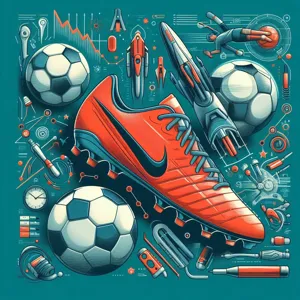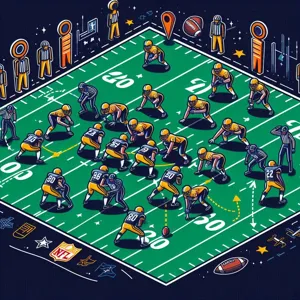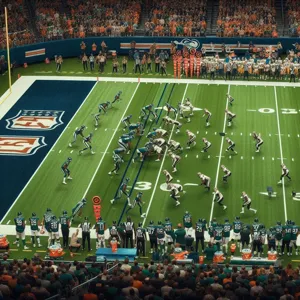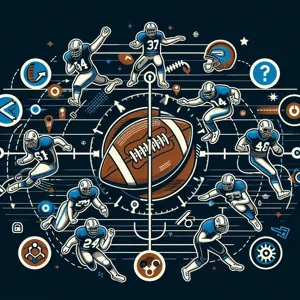In the dynamic world of tennis, where agility and strategy intertwine, the difference between an average player and a master can often be found in the nuances of smart gameplay.
As the sport evolves, so too does the need for players to adopt a more strategic approach that goes beyond just powerful serves and swift volleys. Whether you’re a seasoned competitor looking to refine your technique or a novice eager to improve your skills, understanding the mental and tactical aspects of the game is essential. In this blog post, we will delve into the art of mastering smart tennis, exploring effective strategies that can elevate your performance on the court. From analyzing your opponent’s weaknesses to employing intelligent shot selection and maintaining psychological resilience, prepare to unlock the secrets that will help you think like a pro and play with purpose. get ready to transform your game and gain the competitive edge you’ve been searching for!
1. Understanding Smart Tennis: What It Means to Play Intelligently

Understanding Smart Tennis: What It Means to Play Intelligently
At its core, smart tennis transcends mere physical prowess; it is an intricate blend of strategy, mental acuity, and tactical awareness. Playing intelligently involves recognizing that success on the court is not solely reliant on powerful serves or blistering forehands, but rather on making calculated decisions that can influence the outcome of a match.
To play smart tennis, players must first develop a deep understanding of their own strengths and weaknesses, as well as those of their opponents. This self-awareness allows for the creation of a personalized game plan that capitalizes on advantageous situations while minimizing potential pitfalls. For instance, if you know that your backhand is your weakest shot, a smart player will strategically position themselves to avoid high-stakes rallies that could expose this vulnerability.
Additionally, smart tennis players are keen observers. They pay close attention to their opponent’s patterns, tendencies, and body language, allowing them to anticipate shots and respond accordingly. This kind of strategic thinking means recognizing when to be aggressive and when to play defensively, effectively adapting to the unfolding dynamics of the match.
Moreover, the mental aspect of smart tennis cannot be overlooked. High-pressure situations can often lead to rash decisions, but players who practice mindfulness and maintain composure are better equipped to make informed choices. Visualization techniques and pre-match routines can bolster a player’s mental resilience, ensuring they remain focused and confident on the court.
Finally, embracing the use of technology can further enhance your intelligent play. Analyzing match footage, utilizing performance-tracking apps, and engaging in data-driven practice sessions can provide invaluable insights, allowing players to refine their strategies and optimize their games.
In essence, mastering smart tennis is about cultivating a holistic approach to the game. By combining self-awareness, strategic foresight, mental fortitude, and technological integration, you can elevate your performance and outsmart your opponents, transforming the way you play the sport you love.
2. The Importance of Mental Toughness in Tennis
In the high-stakes world of tennis, where each match can pivot on a single point, the significance of mental toughness cannot be overstated. Unlike many sports, tennis is played in a solitary arena, where athletes are left to navigate not only their physical challenges but also the psychological hurdles they face. The mental aspect of the game often separates the good players from the great ones, and understanding this can be a game-changer for anyone looking to elevate their performance on the court.
Mental toughness in tennis encompasses several key elements: focus, resilience, and confidence. A player with strong mental fortitude can maintain concentration amid distractions, whether it’s the noise of a rowdy crowd or the pressure of a crucial match point. This unwavering focus allows players to execute their strategies and adapt to their opponent’s style without succumbing to nerves or anxiety.
Resilience is equally crucial. Tennis matches can be unpredictable, and even the best players can find themselves facing unexpected setbacks, such as losing a set they were expected to win or battling through a tough match against a lower-ranked opponent. The ability to bounce back from these challenges, to shake off mistakes, and to stay committed to a game plan is often what leads to success on the court.
Equally important is confidence. Believing in one’s skills, trusting in training, and maintaining a positive mindset can dramatically influence performance. Players who approach each match with self-assurance are more likely to take calculated risks, play aggressively, and capitalize on opportunities as they arise. They are also better equipped to manage the inevitable ups and downs of the game, allowing them to stay calm under pressure.
To cultivate mental toughness, players can employ various techniques, such as visualization, mindfulness, and positive self-talk. Imagining successful plays and outcomes can set a powerful tone before stepping onto the court. Mindfulness practices help players stay present, reducing anxiety about past mistakes or future points. Meanwhile, reinforcing positive affirmations can bolster self-confidence and combat negative thoughts.
In essence, mastering the mental aspect of tennis is just as vital as perfecting physical skills. By prioritizing mental toughness, players can navigate the psychological intricacies of the game, allowing them to compete at their highest level while enjoying the journey along the way. As the saying goes, tennis is 90% mental; the remaining 10% is in your head. Embracing this mindset is one of the most effective strategies to elevate your game and achieve the success you aspire to on the court.
3. Analyzing Your Opponent: Key Strategies for Success

Analyzing your opponent is a crucial aspect of mastering smart tennis and can significantly elevate your game. The ability to read your opponent’s strengths, weaknesses, and tendencies allows you to tailor your strategy and exploit gaps in their playstyle. Start by observing their serve patterns—do they consistently favor one side or change it up? Notice how they respond to different types of shots. Are they more comfortable at the net or do they struggle with deep baseline rallies?
Take mental notes during the warm-up. This is an ideal time to gauge their agility, shot precision, and overall court coverage. Assess their footwork—do they move fluidly, or do they seem to drag? Players who are quick on their feet are often harder to outmaneuver, so consider adjusting your shot placements to push them out of their comfort zone.
Moreover, consider the psychological aspect of the game. Pay attention to their reactions after winning or losing points. Do they show signs of frustration or confidence? This can provide insight into how you might leverage momentum shifts during the match. Maintain a strategic mindset and think one step ahead; anticipate their responses and adapt your game plan accordingly.
Remember, analyzing your opponent is not just about gathering information but using it effectively. By developing a keen awareness of their style and tendencies, you can craft a game plan that maximizes your strengths while neutralizing theirs, putting you on the path to victory.
4. Developing a Strategic Game Plan Before Matches
Developing a strategic game plan before matches is a fundamental aspect of mastering smart tennis. Just like a chess player meticulously anticipates their opponent’s moves, a tennis player must enter the court with a well-thought-out strategy that considers both their strengths and weaknesses, as well as those of their opponent.
Start by analyzing your own playing style—are you a powerful server, a consistent baseliner, or a crafty net player? Acknowledging your unique strengths allows you to capitalize on them during the match. Equally important is an understanding of your opponent’s game. If possible, watch their previous matches to identify patterns in their play. Do they struggle with high balls? Are they less effective on their backhand side? Pinpointing these nuances will enable you to devise specific tactics to exploit these vulnerabilities.
Once you’ve gathered enough insight, carve out a detailed game plan that outlines your primary strategies. For instance, if you discover your opponent is weak at returning slice serves, integrate more of these into your serving game. If they tend to overcommit to the net, plan to hit deep, powerful shots that push them back.
Additionally, visualize your game plan. Picture yourself executing your strategies successfully against your opponent. This mental rehearsal can boost your confidence and prepare you for the high-pressure environment of a match.
Remember, flexibility is key. While having a game plan is crucial, be prepared to adapt based on how the match unfolds. Being able to read the game in real time and adjust your strategies accordingly can be the difference between victory and defeat. By taking the time to develop a comprehensive and adaptable game plan before stepping onto the court, you’ll not only enhance your performance but also elevate your overall tennis experience.
5. The Role of Footwork in Smart Tennis

Footwork is often considered the foundation of a successful tennis game, and for good reason. In smart tennis, where strategy and precision take precedence, your ability to move efficiently around the court can significantly elevate your performance. Picture this: as your opponent sends a powerful serve your way, it’s not just about having a quick reaction; it’s about positioning yourself optimally to return that ball with accuracy and control.
Effective footwork allows you to create angles, maintain balance, and strike the ball at the right moment. It involves more than just fast movements; it’s about making those movements purposeful. Engaging in drills that enhance your agility and coordination will help you glide across the court, whether you’re approaching the net for a volley or retreating to cover a deep shot.
Moreover, understanding the rhythm of each rally is crucial. Smart players anticipate their opponent’s next move and adjust their footwork accordingly, allowing them to stay one step ahead. This anticipation can be practiced through shadowing exercises, where you visualize different scenarios and react to them even before they occur.
Incorporating footwork drills into your training routine, such as ladder drills, cone sprints, and side shuffles, can sharpen your quickness and improve your ability to change direction swiftly. Remember, it’s not just about how fast you can run, but how effectively you can move to set yourself up for the perfect shot. When your footwork is on point, you’ll find that your overall game becomes more fluid, and your strategic decisions will flow seamlessly, making you a formidable opponent on the court.
6. Shot Selection: When to Attack and When to Defend
In the dynamic world of tennis, shot selection can often make the difference between victory and defeat. Understanding when to attack and when to defend is crucial for any player looking to elevate their game. It’s not merely about hitting the ball; it’s about making strategic decisions that align with your strengths and your opponent’s weaknesses.
When considering an attacking shot, look for opportunities where your opponent is out of position or has hit a weak return. This is your moment to seize control of the rally. A well-timed forehand down the line or a powerful serve can put your opponent on the back foot, forcing them into a defensive stance. Aim for the corners of the court, as this creates angles that can stretch your opponent and increase your chances of winning the point.
However, not every situation calls for aggression. Recognizing when to defend is equally important. If your opponent is executing powerful shots or you find yourself in a compromising position, focus on maintaining your composure. Defensive shots, such as a slice or a high loop, can buy you precious time to regain your footing and set up for the next play. These shots can disrupt your opponent’s rhythm and give you a chance to regroup.
A smart player knows that shot selection is a blend of tactical awareness and intuition. Practicing this balance during training sessions will help you develop a keen sense of when to take risks and when to play it safe. By mastering the art of shot selection, you’ll not only improve your game but also outsmart your opponents on the court, giving you a significant edge in every match.
7. Utilizing Match Analytics and Technology

In today’s digital age, the fusion of technology and sports has revolutionized the way we approach training and competition, and tennis is no exception. Utilizing match analytics and technology can provide players with invaluable insights into their performance and help them elevate their game to new heights.
Imagine stepping off the court and instantly accessing a wealth of data about your recent match. Advanced analytics tools can break down your performance metrics—tracking everything from your serve speed and accuracy to your shot placement and rally lengths. By analyzing these statistics, you can identify patterns in your play. Are you consistently losing points on your backhand? Is your first serve percentage lower than you’d like? These insights can guide your training focus, allowing you to hone in on specific areas for improvement.
Moreover, many players are now leveraging wearable technology, such as smart watches and motion sensors, to gather real-time data during practice sessions. These devices can monitor your heart rate, movement patterns, and even your stroke mechanics, providing a comprehensive view of your physical condition and technique. With this information at your fingertips, you can make immediate adjustments to your form and strategy, optimizing your performance as you go.
Video analysis is another powerful tool in the arsenal of tech-savvy tennis players. Recording your matches or practice sessions allows for a detailed review of your gameplay. You can analyze your footwork, shot selection, and overall strategy, comparing your style against professional players or simply assessing your own progress over time. Many apps now offer features that allow you to annotate videos, making it easier to pinpoint what works and what doesn’t.
Finally, integrating match analytics into your training regimen can foster a more strategic mindset. Understanding your opponent’s strengths and weaknesses, as revealed through data analysis, equips you with the knowledge to devise tailored game plans. Whether it’s recognizing their tendency to falter under pressure or exploiting their weaker shots, this strategic approach can give you the upper hand in competitive matches.
Incorporating match analytics and technology into your training routine is not just about collecting data; it’s about transforming that data into actionable strategies that directly enhance your performance on the court. By embracing these innovations, you can gain a competitive edge and truly master the art of tennis.
8. The Power of Visualization in Tennis Performance
Visualization is a powerful tool that can transform your tennis performance, enabling players to elevate their game both mentally and physically. This technique involves creating vivid mental images of your desired performance outcomes, from perfect serves to strategic court positioning. By mentally rehearsing these scenarios, you can enhance your focus, boost your confidence, and improve your overall execution on the court.
Imagine standing on the baseline, feeling the grip of your racquet, and seeing the ball soar over the net right where you intended it to land. This mental practice allows you to familiarize yourself with various match situations, helping to ease anxiety and eliminate self-doubt during actual gameplay. Research has shown that athletes who incorporate visualization into their training routines often experience improved motor skills and heightened awareness, leading to better decision-making in high-pressure situations.
To effectively utilize visualization, set aside some quiet time each day to close your eyes and visualize your performance. Picture yourself in a match, executing your favorite shots with precision and finesse. Focus on the sounds, the feelings, and the atmosphere surrounding you—this immersive experience creates a neural pattern in your brain that translates to real-life performance.
Incorporating visualization into your pre-match routine can also serve as a powerful mental warm-up. Spend a few moments before stepping onto the court visualizing yourself playing your best game, recalling successful plays from past matches, or imagining how you will respond to various challenges. This mental clarity not only enhances your confidence but also prepares your mind and body to perform at peak levels.
By mastering the art of visualization, you can tap into a deeper understanding of your game, refine your skills, and foster a winning mindset, ultimately leading to improved performance and greater enjoyment of the sport. Embrace the power of your imagination, and watch as it elevates your tennis game to new heights.
9. Practicing Mindfulness on the Court
Practicing mindfulness on the court is a game-changer for tennis players at any level. In a sport where focus and mental clarity can make or break a match, cultivating a mindful approach can enhance your performance and enjoyment of the game. Mindfulness in tennis involves being fully present during each point, tuning into your breath, and maintaining awareness of your body and movements.
Start by incorporating simple breathing exercises into your warm-up routine. As you take to the court, take a moment to center yourself. Inhale deeply, allowing your abdomen to expand, and exhale slowly, releasing any tension. This practice not only calms your mind but also prepares your body for the physical demands ahead.
During play, pay attention to the sensations of the racket in your hand, the feel of the court beneath your feet, and the sound of the ball as it strikes the strings. By immersing yourself in these sensory experiences, you can better manage distractions, whether they come from the crowd, your opponent, or even your own thoughts. If you find your mind wandering or anxiety creeping in, gently guide your focus back to the present moment, reminding yourself to stay engaged with the game at hand.
Mindfulness can also be applied to your strategy. Instead of fixating on the score or the outcome of the match, concentrate on executing each shot with intention and precision. Emphasize the process over the result; this shift in perspective can alleviate pressure and enhance your overall performance.
Moreover, consider incorporating post-match mindfulness practices to reflect on your gameplay. Take a few minutes to analyze your performance without judgment—acknowledging your strengths and identifying areas for improvement. This reflective practice fosters a growth mindset, helping you become a more resilient and adaptable player.
By embracing mindfulness on the court, you not only elevate your game but also deepen your love for tennis. With each match, you cultivate a greater sense of awareness and connection to the sport, ultimately leading to improved focus, reduced stress, and a more fulfilling tennis experience.
10. Adapting Your Strategy During a Match
In the fast-paced world of tennis, the ability to adapt your strategy during a match can be the key to victory. As you step onto the court, it’s crucial to enter with a flexible mindset, ready to adjust your game plan based on the dynamics unfolding before you. Every opponent brings a unique style, strengths, and weaknesses, and recognizing these early can provide you with a significant advantage.
Pay close attention to your opponent’s patterns. Are they consistently favoring one side of the court? Do they struggle with your powerful serve or quick volleys? Understanding these nuances can help you pivot your approach effectively. For instance, if you notice your opponent struggling to return shots hit to their backhand, consider targeting that area more frequently. Conversely, if they seem to thrive when you play aggressively, it might be time to embrace a more defensive strategy, focusing on consistency and placement instead of power.
Moreover, be mindful of your own performance throughout the match. If fatigue sets in or your shots are less precise, it may be time to recalibrate your tactics. This could involve extending rallies rather than going for quick points, allowing yourself time to regroup and regain focus. Alternatively, if you find yourself on a winning streak, don’t be afraid to seize the momentum and play more aggressively.
Communication with your coach or team during changeovers can also provide fresh perspectives. Their insights might highlight adjustments you hadn’t considered, allowing you to refine your strategy further. Remember, adaptability is not just about changing your shots; it’s about being attuned to the shifting flow of the match and responding with confidence and creativity.
Ultimately, mastering the art of adapting your strategy during a match requires practice and intuition. Embrace each match as an opportunity to learn, and soon, you’ll find that your ability to pivot on the court will elevate your game to new heights, making you a formidable opponent in any situation.
11. Importance of Physical Fitness and Conditioning
Physical fitness and conditioning are the bedrock of any successful tennis player’s game. While technical skills and mental strategies play crucial roles, the ability to move swiftly on the court, maintain endurance throughout long matches, and recover quickly between sets often makes the difference between winning and losing. Tennis is a physically demanding sport that requires a unique combination of strength, agility, flexibility, and cardiovascular fitness.
To elevate your game, it’s essential to incorporate a well-rounded fitness regimen that targets the specific demands of tennis. This means engaging in strength training to build core muscles, which are vital for powerful serves and groundstrokes. Exercises like squats, lunges, and resistance training can enhance your explosiveness and stability, allowing you to change directions swiftly and effectively.
Agility drills, such as ladder exercises and cone drills, are equally important. These workouts improve your foot speed and coordination, enabling you to position yourself better for each shot. Moreover, incorporating plyometric exercises, like box jumps and medicine ball slams, can drastically improve your reaction time and overall athleticism on the court.
Don’t forget about flexibility—yoga and stretching routines can prevent injuries and enhance your range of motion, allowing you to execute those tricky shots with ease. Finally, maintaining cardiovascular fitness is crucial for stamina; long-distance running, cycling, or interval training can help ensure you have the endurance to outlast your opponent, especially in those grueling matches that stretch into multiple sets.
In summary, prioritizing physical fitness and conditioning is not just an ancillary part of your training; it is a fundamental strategy to master smart tennis. By investing time and effort into your overall physical health, you will find yourself more equipped to tackle the demands of the game, leading to improved performance, greater resilience, and ultimately, a more enjoyable tennis experience.
12. Mental Recovery: Strategies for Post-Match Reflection
Mental recovery is a critical aspect of any athlete’s journey, yet it is often overlooked in the hustle of training and competition. After an intense match, whether you emerged victorious or faced a tough defeat, taking time for post-match reflection can significantly enhance your overall performance and mental resilience.
To begin, find a quiet space where you can unwind. This could be a secluded area of the court, a cozy corner of your home, or even a tranquil park. Allow yourself to decompress physically and mentally. Deep breathing exercises can help ground you and clear your mind, making way for focused reflection.
Once you feel centered, take out a journal or a digital device and jot down your immediate thoughts about the match. What went well? Identify the moments when you executed your strategies effectively, whether it was a well-placed serve or a strategic rally. Celebrate these successes, no matter how small—they are crucial in building your confidence and reinforcing positive behaviors.
Next, consider the areas for improvement. Be honest with yourself, but also be constructive. Instead of dwelling on mistakes, frame your observations as learning opportunities. For instance, if you struggled with your backhand, note specific instances in the match where it could have been better. This will allow you to target this skill in your upcoming training sessions.
Engage in a mental rehearsal of key points from the match. Visualize those moments, both successful and challenging, and imagine different outcomes. This mental simulation not only prepares you for future matches but also solidifies your learning process.
Finally, set actionable goals for your next steps. Whether it’s refining a particular technique or focusing on mental toughness, having clear objectives will give you direction and purpose in your practice sessions.
Remember, mental recovery is not just about reflection; it’s about growth. By investing time in this critical phase after every match, you’ll cultivate a mindset that embraces learning and resilience, ultimately elevating your game in ways you never thought possible.
13. Learning from Losses: Turning Defeats into Opportunities
In the realm of sports, particularly in tennis, the sting of defeat can be a powerful teacher. Learning from losses is not merely a cliché; it is a vital strategy for mastering the game and elevating your performance on the court. Each match comes with its unique set of challenges, and understanding these obstacles can transform setbacks into stepping stones for future success.
After a loss, take the time to analyze the match critically. What were the pivotal moments that swung the game in favor of your opponent? Did you struggle with your serve, or were you unable to respond effectively to their playing style? Consider keeping a match journal where you jot down key observations and feelings immediately after each game. This reflection helps you identify patterns in your play, revealing both strengths to build on and weaknesses to address.
Moreover, don’t shy away from seeking feedback. Engaging with your coach or more experienced players can provide invaluable insights that you might not see yourself. They can highlight areas for improvement, suggest targeted drills, and even share their own experiences of overcoming similar challenges. Remember, every player, no matter how skilled, has faced defeats. Embracing this shared experience fosters resilience and a growth mindset.
Transforming a loss into an opportunity also involves setting specific, actionable goals based on your reflections. Instead of focusing solely on winning your next match, aim to improve particular aspects of your game, such as footwork or net play. By honing in on these smaller objectives, you’re not just preparing for your next match; you’re laying the groundwork for long-term improvement.
Finally, maintain a positive outlook. Each defeat is a chapter in your journey, not the conclusion of your story. Celebrate the lessons learned, and remind yourself that every champion has faced adversity. With each loss, you are not just getting closer to your goals; you are becoming a more resilient and strategic player. Embrace the challenges, and watch as your game transforms, turning defeats into powerful opportunities for growth.
14. Building a Support System: Coaches, Trainers, and Peers
Building a strong support system is essential for any tennis player looking to master the game. Surrounding yourself with coaches, trainers, and peers can significantly enhance your skills, motivation, and overall enjoyment of the sport.
Coaches are invaluable assets in your tennis journey. They provide expert guidance, offering personalized feedback on your technique, strategy, and mental approach to the game. A good coach can identify your strengths and weaknesses and help you develop a tailored training plan that aligns with your goals. Whether you’re a beginner or an advanced player, having a coach to guide you through drills, match simulations, and competitive strategies can make all the difference.
In addition to coaches, trainers play a crucial role in your physical conditioning. Tennis is a demanding sport that requires agility, strength, and endurance. A trainer can design a workout regimen that complements your on-court practice, focusing on building the specific muscle groups and fitness levels necessary for peak performance. They can also help prevent injuries by teaching you proper stretching techniques and recovery strategies, ensuring you remain in top shape throughout the season.
Equally important are your peers—fellow tennis enthusiasts who share your passion for the game. Engaging with peers not only provides a social aspect to your training but also creates opportunities for practice matches and friendly competition. Training with friends can push you to elevate your skills, offering a chance to learn from one another and share strategies.
Moreover, your support system can also include online communities and tennis clubs where you can connect with others who share your interests. These networks can provide valuable resources such as tips, training videos, and even local tournaments to participate in, further enriching your learning experience.
In essence, building a diverse support system that includes coaches, trainers, and supportive peers will create a positive environment that fosters growth and improvement. As you navigate your tennis journey, remember that collaboration and support are key components in mastering smart tennis and taking your game to the next level.
15. Continuous Improvement: Setting Goals for Your Tennis Journey
Continuous improvement is the cornerstone of any successful athlete’s journey, and in the realm of tennis, setting clear, achievable goals can be the catalyst that propels you forward. Whether you’re a novice eager to learn the basics or an experienced player aiming to refine your skills, having a structured approach to your development is essential.
Start by identifying specific areas of your game that require attention. This could range from enhancing your serve, improving your footwork, or mastering your backhand. Once you’ve pinpointed these focal points, break them down into actionable, measurable goals. Instead of a vague aspiration like “I want to be a better player,” consider setting a goal such as “I will practice my serve for 30 minutes three times a week” or “I will watch and analyze one professional match each week to learn new strategies.”
Incorporate both short-term and long-term goals into your plan. Short-term goals provide immediate targets that can keep you motivated, while long-term goals offer a broader vision of where you want to be in the future. For instance, a short-term goal might involve participating in a local tournament, while a long-term objective could be to compete at a higher level within the next year.
Track your progress regularly. Keeping a journal or using a tennis app can help you document your improvements, setbacks, and milestones. Reflecting on your journey not only boosts accountability but also helps you celebrate small victories along the way, reinforcing your commitment to continuous improvement.
Finally, be flexible with your goals. As you evolve as a player, your aspirations may change. Embrace the journey of learning and adjust your objectives as needed. Remember, the essence of mastering smart tennis lies not just in winning matches, but in the dedication to grow, adapt, and enjoy every step of the process.
In conclusion, mastering smart tennis is not just about improving your physical skills; it’s about understanding the game on a deeper level and applying strategic thinking to elevate your performance. By implementing the strategies we’ve discussed—such as optimizing your court positioning, enhancing your shot selection, and developing mental resilience—you can transform your approach to the game and gain a competitive edge over your opponents. Remember, every match is an opportunity to learn and adapt, so embrace the process and stay committed to your growth as a player. As you step onto the court, carry these insights with you and watch as your game reaches new heights. Here’s to smarter play, greater victories, and a more fulfilling tennis experience!




































